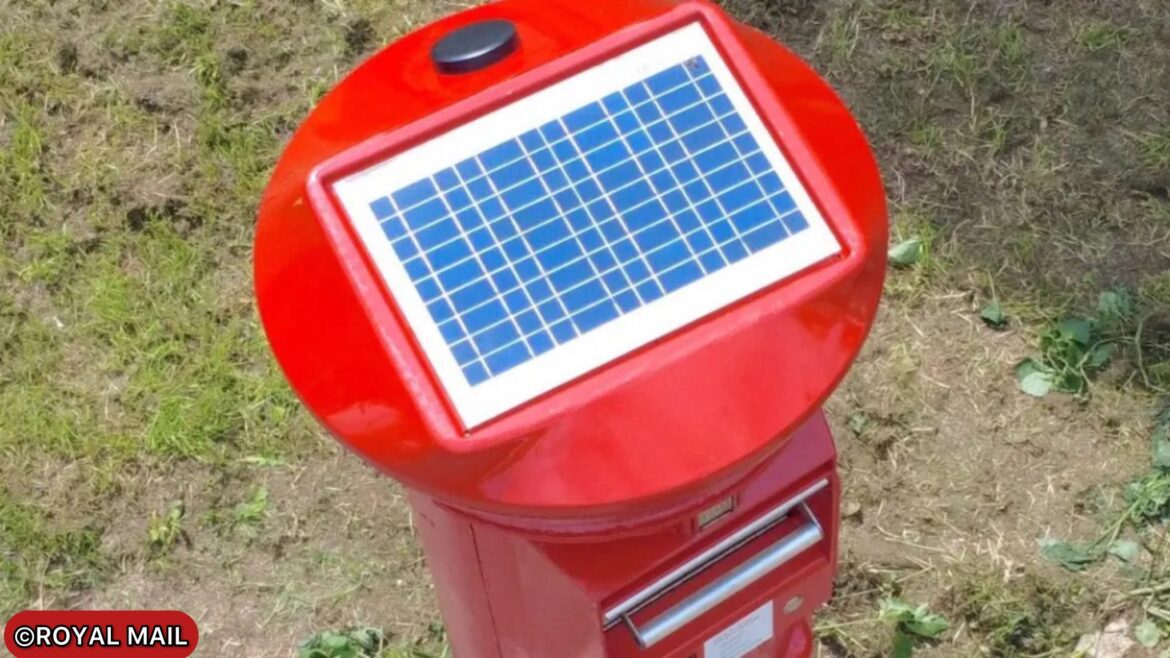Royal Mail is deploying 3,500 solar-powered postboxes equipped with digital technology across Britain in what the company describes as the “biggest change to postbox design since their introduction more than 175 years ago”.
The innovative postboxes feature barcode scanners and automated drawers capable of accepting parcels up to shoebox size, marking a significant departure from the traditional letter-slot-only design that has remained largely unchanged since the mid-19th century.
However, the modernisation has disappointed members of craft groups who regularly decorate postboxes with knitted toppers for charity fundraising and community events.
Jack Clarkson, Royal Mail’s managing director for out-of-home and commercial excellence, said the transformation reflects changing consumer habits. “We are all sending and returning more parcels than ever before. This trend will only continue as online shopping shows no signs of slowing, particularly with the boom of second-hand marketplaces.”
The redesigned postboxes incorporate south-facing solar panels on their lids, which power the integrated barcode scanner and electronic drawer mechanism. Users activate the system by scanning their parcel’s barcode through the Royal Mail app, triggering the drawer to open automatically.
“There are 115,000 postboxes in the UK located within half a mile of 98 per cent of addresses, making them by far the most convenient network of parcel drop-off points in the UK,” Clarkson added. Our message is clear, if you have a Royal Mail label on your parcel, and it fits, put it in a postbox and we’ll do the rest.
The technology targets consumers processing e-commerce returns and individuals selling items through online marketplaces such as Vinted, eBay, and Depop. Traditional letter posting remains available through a separate slot, ensuring the postboxes retain their original function.
Following successful pilots in Hertfordshire and Cambridgeshire earlier this year, Royal Mail confirmed the nationwide rollout would include major cities such as Edinburgh, Manchester, Nottingham, Sheffield, and Sunderland. The company tested two designs during trials, ultimately opting for a version that maintains the iconic red finish with a white-topped grid of solar panels.
Emma Gilthorpe, Royal Mail’s chief executive, described the upgrade as giving postboxes “a new lease of life on street corners across the nation”. She emphasised the shift in postal volumes: “In an era where letter volumes continue to decline and parcels are booming, we are giving our iconic postboxes a new lease of life.”
The digital system requires users to affix Royal Mail labels to their packages, which can be printed at home or obtained from Post Office locations. The app provides proof of posting and enables customers to track parcels throughout delivery, addressing common concerns about package security.
However, the modernisation has created unexpected disappointment among Britain’s crafting community. Melanie Delaney, a 51-year-old science teacher and member of the Secret Society of Hertford Crafters, expressed frustration about being unable to decorate her local solar-powered postbox.
“We bring joy to everybody around, and that’s our motto – bring joy to Hertford,” Delaney told reporters. The group has gained national recognition for their elaborate knitted postbox toppers, which have raised tens of thousands of pounds for various charities.
The Secret Society of Hertford Crafters, comprising approximately 150 members, has created numerous installations since 2017, including Olympic-themed displays and Christmas decorations. Their 2017 Christmas toppers alone raised over £14,000 for Isabel Hospice, whilst a commemorative poppy cascade at Hertford Castle for the First World War centenary generated £17,000 for the Royal British Legion.
The solar panels’ placement on top of the postboxes prevents the attachment of knitted decorations, effectively ending a charitable tradition that has flourished across Britain in recent years. Craft groups regularly create themed toppers for events ranging from royal celebrations to local fundraisers.
Royal Mail’s expansion comes as the company faces intense competition from private courier services and parcel locker providers such as InPost and Yodel. The postal service now operates over 23,500 parcel points nationwide, including 2,000 parcel lockers, 7,500 Collect+ stores, 11,500 Post Office branches, and 1,200 customer service points.
The technology represents a significant infrastructure investment as Royal Mail adapts to changing consumer behaviour. Online shopping returns have surged in recent years, with fashion retailers reporting return rates of up to 40 per cent for online purchases.
Industry analysts suggest the move positions Royal Mail to compete more effectively in the rapidly evolving parcel delivery market. The integration of smartphone technology with traditional postal infrastructure reflects broader digitalisation trends across the logistics sector.
The postboxes utilise 4G connectivity and location services through the Royal Mail app, enabling real-time tracking and digital proof of posting. The solar-powered system includes internal batteries to ensure functionality during overcast conditions, addressing concerns about reliability in Britain’s variable weather.
Royal Mail has indicated that thousands of existing postboxes could be retrofitted with the new technology, though specific timelines and locations for the wider rollout remain to be confirmed. The company’s strategy acknowledges that whilst postboxes remain within half a mile of 98 per cent of UK addresses, their traditional letter-only function increasingly fails to meet modern consumer needs.
The first red pillar boxes appeared in Britain in 1853, initially painted green before standardisation to the now-iconic red in 1874. This latest evolution represents the most significant design change in the postbox’s history, transforming a Victorian-era invention into a 21st-century parcel solution.
As the rollout progresses, the balance between modernisation and preserving community traditions remains a point of contention, highlighting the challenges faced by national institutions adapting to technological change whilst maintaining their cultural significance.
Follow for more updates on Britannia Daily
Image Credit:
Royal Mail Post Box, Pomeroy — photo by Kenneth Allen, taken on 24 June 2013 in Pomeroy, Northern Ireland. Licensed under Creative Commons Attribution-ShareAlike 2.0 Generic (CC BY-SA 2.0)



